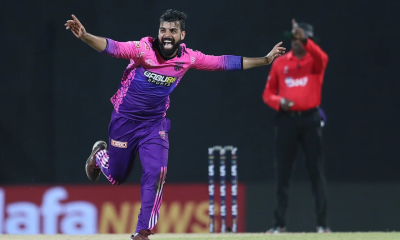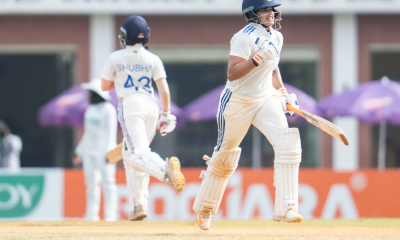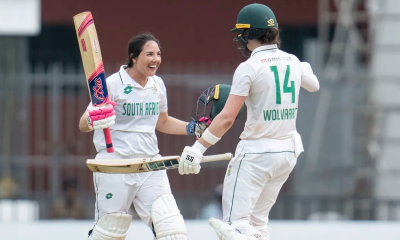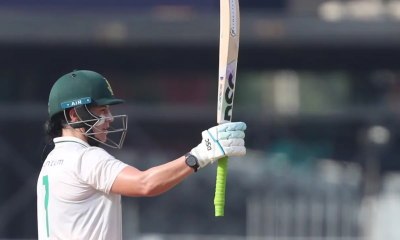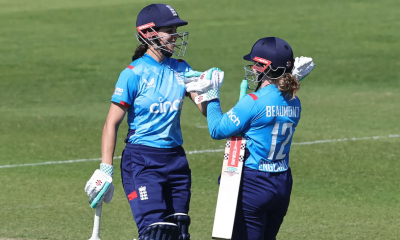Sports
T-20 becoming most popular brand of cricket

by Rex Clementine
Test cricket being the highest form of the game and a real test of character are all true no doubt but T-20 cricket has become the most popular format of the game for a variety of reasons. There’s more money being invested by sponsors for T-20 cricket as that’s where you see the younger generation getting involved. In a fast paced world, after five days of Test cricket, younger generations find it difficult to come to terms with the fact that games can still end in no results. They are more comfortable with the fact that three hours of T-20 entertainment gives them a result.
The eighth edition of the event is taking place in Australia for the first time and the Aussies are known to be fabulous hosts and put up grand shows. Their government is giving the fullest backing with visa fees and biometrics exempted for players, officials and even journalists. With some entertaining finishes and new heroes, this tournament is expected to take the popularity of T-20 cricket further.
There’s an increasing trend for teams to engage in more T-20 cricket than Test matches. For example, Pakistan and England recently played seven T-20 Internationals but there’s only room for three Tests. Australia and Sri Lanka have ended up playing eight T-20s this year alone but their Test series won’t stretch beyond two games.
It is true that the money is in T-20 cricket, but it shouldn’t be at the expense of Tests. In reality, the tendency to play fewer Tests has become the norm as most boards end up incurring huge costs playing Tests and they make little money.
Countries like Sri Lanka need to be aware of the dangers of playing fewer Test matches. England, Australia and even India will not cut down on the number of Tests they play a year as they can sustain it even when they don’t make profits. Sri Lanka’s red ball players were involved in a Test series in July this year and need to wait till march next year for their next series.
It has only taken two decades for T-20 cricket to expand beyond imagination. The financial riches T-20 cricket has brought in is such that Sri Lankan cricketers now can afford to buy acres of prime land. No not just around Colombo, but even in places like Melbourne and Manchester. Yes, that’s correct, acres of prime land. T-20 cricket was first introduced in England in 2003. Lord Ian MacLaurin, the boss of UK’s most successful supermarket chain Tesco was the head of England and Wales Cricket Board and he brought in much needed change for the game.
ECB Marketing Executive Stuart Robertson had been told to look into ways that would make cricket appealing to younger fans in Britain again. It had been observed that there was this notion that cricket was a sport for the wealthy. The sport was being played while most men and women in UK were at work.
Robertson noted that even in limited overs cricket, it took seven hours for a game to end. Furthermore, 50 overs cricket at that point was losing interest. The first 15 overs with field restrictions were on was exciting and then the last five with batters cashing in towards the end of the innings. Between overs 16 and 44 was considered as a boring phase of the game. So he decided to take off the period between overs 16 to 44 and condense it to a 20 over game hoping the excitement was there.Activities where children can come over and enjoy the game were introduced too like bouncy castles and swimming pools and the idea was immensely popular in England.
India brought into the argument reluctantly. Jagmohan Dalmiya, cricket’s most powerful man at that point walked into the Durban press box during the 2003 50 over World Cup semi-final and the British media told him about the success of T-20 cricket in UK and asked whether international cricket could accommodate another format. Dalmiya said that in his part of the world the game was thriving. His famous quote was, ‘when there’s a Test match in Calcutta, there are 100,000 people inside the ground and 100,000 people outside the ground.’
But all that changed four years later when India won the first T-20 World Cup in South Africa in 2007. BCCI hadn’t taken the tournament seriously and sent a second string team. But that team had a smart leader, a certain M.S. Dhoni. Once India won the title beating arch-rivals Pakistan, the interest for the new format went through the roof.
Cricket landscape was also changing in India at that point and more dynamic and young businessmen like Lalit Modi and N. Srinivasan were taking charge. They saw the huge potential a domestic T-20 tournament would have and the IPL was launched. Rest of the world followed suit with their own lucrative T-20 league and the rest as they say is history.
Sports
OTRFU Beach Tag Rugby Carnival on 24th May at Port City Colombo

The Old Thomian Rugby Football Union [OTRFU] is set to celebrate seven decades of rugby at S.Thomas’ College Mt Lavinia, by holding a Beach Tag Rugby Carnival at the Club House premises of the Port City Colombo from 3.00p.m. onward on Saturday 24th May 2025.
President of the OTRFU Ashean Karthelis speaking at a press briefing held to launch the event at the CR and FC club house said that the Beach Rugby Carnival was a land mark event commemorating the legacy and spirit of Thomian rugby. He added that with 27 sponsors coming on board the event was bound to be a tremendous success and would be more an evening of fun and frolic for the whole family rather than a beach tag rugby competition.
Tournament Director Dilroy Fernando said that the inaugural beach tag rugby carnival organised by OTRFU will be a seven a side event limited to sixteen teams. Each team is to comprise 12 male players and two female players and it was compulsory that the playing seven include a female player at all times. Fernando said that the entry fee per team would be Rs 10,000/- and would include kits, refreshments and more.
The Cup champions will receive a cash award of Rs 200,000/-, Cup runners up Rs 100,000/- and the Most Valuable Male and Female player Rs 25,000/- each
He added that players who represented ‘A’ division club teams during the 2024 / 2025 season in league, knock out or sevens tournament will not be eligible to participate
Latest News
IPL 2025: Narine’s all-round show sets up tense win for Kplkata Knight Riders

Latest News
Brits ton in vain as Rana five-for scripts India’s thrilling win

India defended 276 – their third highest-score against South Africa – in dramatic fashion to record successive wins in the Sri Lanka tri-series. South Africa were fairly comfortable on 170 for 2 after 33 overs chasing 277 and Tazmin Britts had scored her third ODI hundred and was anchoring their effort. With the required run-rate a touch above six an over, Brits retired hurt with cramp and that sent South Africa into freefall. They lost eight wickets for 80 runs, including three in an over to Sneh Rana, who finished with career-best figures of 5 for 43, and fell short by 15 runs.
Brits’ need to leave the field to seek medical assessment was one reason South Africa lost their tri-series opener but there were several others. Pratika Rawal’s 78 – her fifth successive fifty-plus score in the format which also made her the fastest to 500 runs in ODIs – set India up well and twin 41s from Harman preet Kaur and Jemimah Rodrigues and a 14-ball 24 from Richa Ghosh helped India score 82 runs in the last ten overs. Their total was helped to balloon beyond South Africa’s reach thanks to 13 wides they sent down. India, for comparison, only bowled two wides and a no-ball.
Overall, India’s ground fielding was sharper, though they put down three catches which included Brits’ twice, and their spinners controlled the middle period well. Rana and Deepti Sharma conceded 83 runs between them in their 20 overs while Shree Charani bowled ten overs with figures of 1 for 51.
After India cruised past Sri Lanka in the series opener, they were challenged by a South African side who have not played together for more than four months and looked rusty, especially against Smriti Mandhana and Rawal. The pair put on 83 for the opening stand, with Mandhana initially taking most of the strike and playing the aggressor role while Rawal eased herself in. South Africa started to rein them in and gave away no boundaries between the tenth and 18th over – by which point they had used five different bowlers – and then brought Annerie Dercksen on to try and get a breakthrough.
She benefited from the pressure her colleagues had created. After delivering two wides in her first four balls, Dercksen went short, down leg, Mandhana followed and gloved the chance to Karabo Meso, who took her first ODI catch. Dercksen’s over was still poor as she conceded 19 runs, including five wides and the six over deep mid-wicket that got Rawal to fifty.
Rawal was given a life when she was on 71 and flicked Masabata Klaas to deep square leg, where Chloe Tryon ran to her right to get to the ball but could not hold on. South Africa then thought they had run Harleen Deol out off the next ball when Meso flicked the bail off and Deol seemed short of her ground but the third umpire disagreed. Just as South Africa may have wondered where another wicket would come from, Mlaba ended their frustration with a double strike. In the 31st over, she bowled Rawal with a beauty that dipped and turned past the outside edge to hit offstump and in the 33rd, drew Deol forward to bowl her with a full ball.
Harmanpreet, batting for the first time in ODIs this year, should have been caught at deep cover when she sliced Nadine de Klerk to Lara Goodall but was put down on 4. Despite the miss, South Africa squeezed hard and India were unable to find the boundary for ten overs, until Dercksen returned. She continued to struggle with her lengths and conceded 17 off her second over as India entered the final ten on 195 for 3.
Rodrigues and Harmanpreet’s stand grew to fifty and Rodrigues was playing her shots but when she tried to scoop Klaas over fine leg, only managed to find Ayabonga Khaka at 45. Ghosh played an aggressive cameo and scored 24 runs off the 14 balls she faced and India plundered 82 runs in the last ten overs, including nine fours and a six.
By the time South Africa got to the last ten overs of their innings, they needed 81 runs and had seven wickets in hand. Brits had retired by then in what has been called extreme heat even by Colombo standards but would have felt she’d set her team-mates up well. She dominated the 140-run opening stand with Laura Wolvaardt – South Africa’s second highest for the first wicket – and scored 90 runs off 93 balls to Wolvaardt’s 43 off 75. Brits was also put down twice, on 51 by Deepti off her own bowling and 67 by Harmanpreet at mid-off. Deepti was eventually rewarded when Wolvaardt was hit on the pads as she tried to work her into the legside and given out lbw which allowed India to start to claw their way back.
Goodall, playing in place of the injured Anneke Bosch, played all around a Rana arm ball and was bowled but with Brits still there, South Africa seemed in control. She reached her hundred off the 103rd ball she faced and then blasted two fours in the same over but after the second, could not continue. Her partner at the time was 17-year old Meso, who suddenly found herself with a big job.
Meso was on 7 off 17 balls when she tried to hit Arundhati Reddy through the off-side but played on which brought the experienced pair of Sune Luus and Tryon together. The required run-rate had climbed over seven. Luus was dropped in the 41st over when she gave Reddy a knee-height chance in her follow through but then holed out to deep mid-wicket in the next over. South Africa needed 70 off 50 balls. Tryon and Dercksen got that down to 41 off 30 before Tryon chipped Rana to midwicket in her penultimate over. Rana’s last over was the one South Africa had to survive.
Instead, de Klerk was bowled trying to sweep off the second ball, Dercksen mistimed a slog sweep to deep square leg and Brits came out again only to hand Rana a return catch and end South Africa’s hopes. They went from 249 for 5 to 252 for 8 and had no recognised batters left. Their last two batters were run-out as India sealed the win with four balls to spare and cemented themselves at the top of the points table.
Brief scores:
India Women 276 for 6 in 50 overs (Pratika Rawal 78, Smriti Mandhana 36, Harleen Deol 29, Jemimah Rodrigues 41, Harmanpreet Kaur 41*, Richa Ghosh 24; Nomkululeko Mlaba 2-55) beat South Africa Women 261 in 49.2 overs (Laura Wolvaardt 43, Tazmin Brits 109, Sunee Luus28, Aneerie Dercksen 30; Sneh Rana 5-43) by 15 runs
[Cricinfo]
-

 Business3 days ago
Business3 days agoPick My Pet wins Best Pet Boarding and Grooming Facilitator award
-

 News3 days ago
News3 days agoNew Lankan HC to Australia assumes duties
-

 News1 day ago
News1 day agoJapan-funded anti-corruption project launched again
-

 News3 days ago
News3 days agoLankan ‘snow-white’ monkeys become a magnet for tourists
-

 Features3 days ago
Features3 days agoKing Donald and the executive presidency
-

 Business3 days ago
Business3 days agoACHE Honoured as best institute for American-standard education
-

 Features5 days ago
Features5 days agoThe Truth will set us free – I
-

 Business1 day ago
Business1 day agoNational Savings Bank appoints Ajith Akmeemana,Chief Financial Officer





